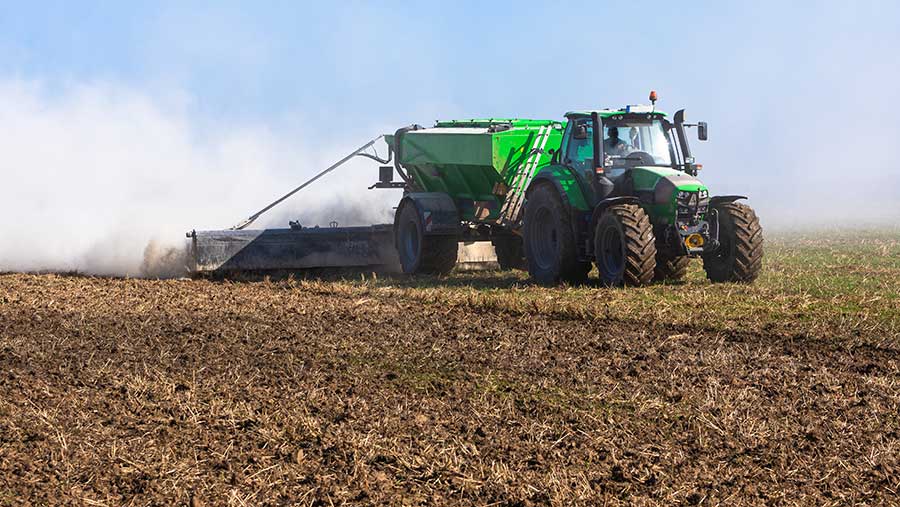Farms buy lime as fertiliser trades near £500/t
 © Martin Schecht/Adobe Stock
© Martin Schecht/Adobe Stock A two-fold increase in ammonium nitrate prices should prompt farmers to focus on sourcing lime products to optimise soil pH levels.
Fertiliser prices have skyrocketed this autumn, with October/November quotes of ammonium nitrate at £475-£480/t.
Gas prices, haulage issues and panic-buying have combined to stoke fertiliser values, while lime prices are relatively stable in comparison.
See also: Dairy farm profits in last milk year down £48 a cow
This is according to fertiliser consultant George Fisher, who said lime will provide a better return on investment in the coming months as part of the AHDB Grass Campaign.
He said maintaining a soil’s pH of around 6.5 is best for efficient production. Long-standing research shows grass yield can be 30-40% lower as pH drops from 6.5 to 5.5pH.
Benefits of optimal pH soils
- Increases the soil’s ability to release nutrients to the crop
- Optimises conditions for soil biology and health
- Cuts down on expensive nutrients being wasted and water course pollution
- Improves the efficiency of nitrogen capture by legumes
- Evidence is growing to suggest low and high pH soils lose more carbon
Source: Dr George Fisher
Sales of lime up
Agricultural lime sales had already gone up as farms looked for alternatives, according to Mick Stovin of LKAB Minerals and chairman of the Agricultural Lime Association (ALA).
He had seen lime sales increase 25% at LKAB in the past three months. Volumes were up 15% for the year so far, compared with the same period in 2020.
He said that calcium lime from a local quarry or supplier was proving a safe bet for some farms as market volatility took hold.
“In 38 years in the industry, this is the first time I’ve seen procurement people have nothing to bargain with at all,” said Mr Stovin. “There’s no way to bargain on labour or haulage costs, everything is so expensive.”
He said limited shipping capacity in the Mediterranean was having an impact on shipping costs, and, further afield, the cost of minerals from China had increased more than 10-fold purely on shipping container transport.
“We used to be charged US $1,200 [£883] to get a container from China to the UK – that’s before it had anything in it. Now it’s US $17,000 [£12,508], which is a cost that has gone up since September last year.”
Dr Fisher said: “You can work away on the physics and biology, but if you don’t have the pH right, you will still lose nutrients.
“But get them all right and you reduce your chances of nutrient loss, leaching and pollution, and increase your chances of a healthy and high-yielding crop.”
“It doesn’t matter when you lime if ground conditions are suitable, but if you do it now, at the end of the grazing season, it has the winter to work its way into the soil and positively impact the pH next season.”
Source the best
Mr Stovin warned farmers that soil tests should be undertaken before lime products were bought to understand just how much was needed and whether calcium lime was best for their farm.
Conventional bulk lime products could be delivered and spread for a cost of £22/t, but Mr Stovin stressed that not all of the lime in such products was the optimal particle size.
Granulated products would break down in the field faster and start affecting soils sooner.
Mr Stovin said: “If I put a limestone brick in a field for a year, I can go back a year later and it’s still there, but smaller particles of lime disappear into the soil much faster.”
How to source lime
- Start with a soil test to find out mineral status and pH levels
- Once pH is known, use the calculator on ALA’s website to specify tonnage and types of products, according to your farm’s soil type
- Ask your supplier if it is compliant with the Aglime Quality Standards (AQS) as drawn up by the ALA
- Look for products with a neutralising value (NV) of 52-54
- Check the reactivity of the product, which relates to its size – anything 150 microns and lower is good
- Opt for calcium-based products before considering brands and types
Source: Dr George Fisher and Mick Stovin
